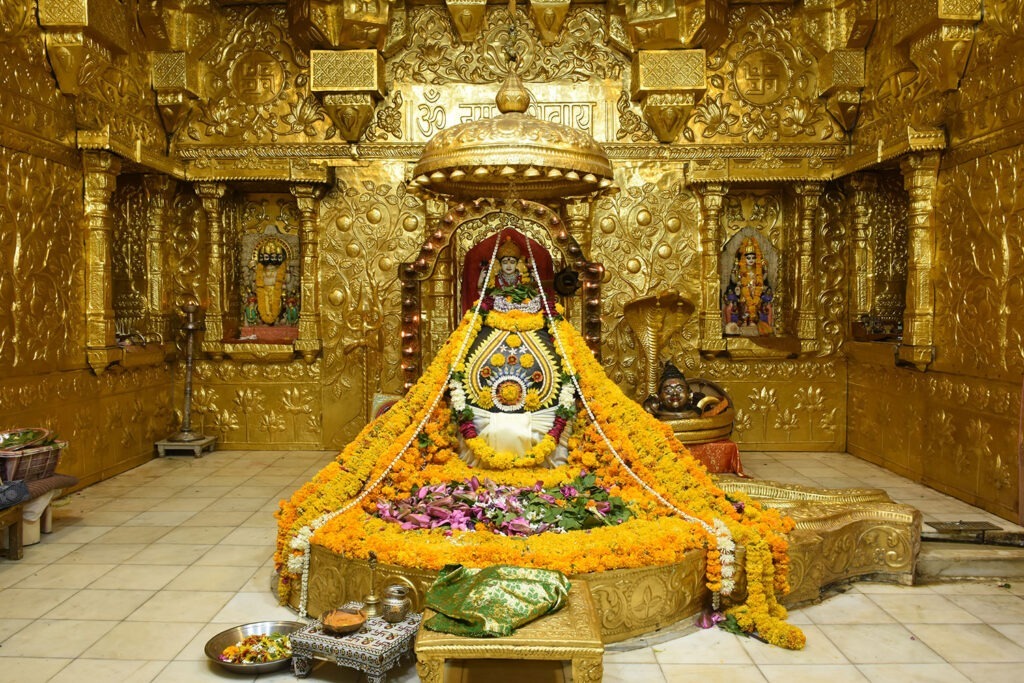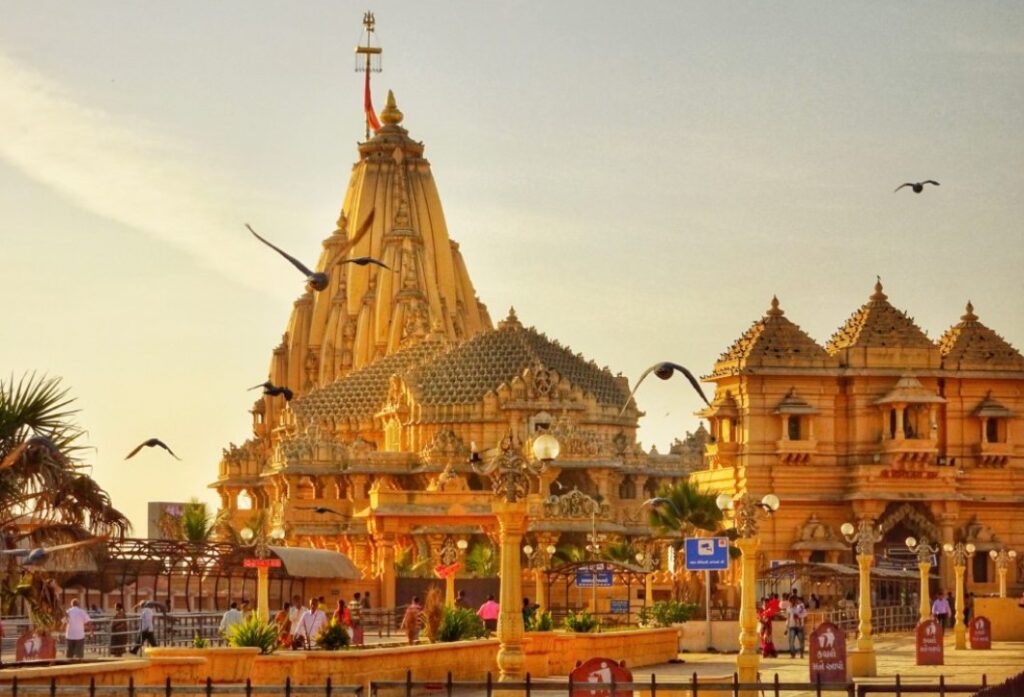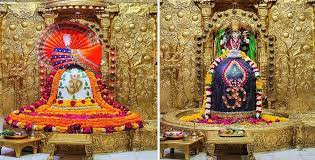
Shree Somnath Jyotirling Temple
Shree Somnath Jyotirling Temple, nestled in Prabhas Patan near Veraval in Saurashtra, Gujarat, stands as a monumental symbol of spiritual devotion and architectural grandeur. Revered as the first among the twelve Jyotirlingas dedicated to Lord Shiva. The temple’s seafront location, overlooking the Arabian Sea, adds a unique dimension to the spiritual experience, creating a serene ambiance where devotees engage in prayers, rituals, and aarti to seek the divine blessings of Lord Shiva. Shree Somnath Jyotirling Temple remains a sacred pilgrimage site, drawing pilgrims and tourists alike who are captivated by its historical significance, spiritual atmosphere, and the breathtaking confluence of land and sea.
Historical background and Architectural splendor
This temple has a long and turbulent history, as it was destroyed and rebuilt several times by various invaders and rulers. However, one of the most fascinating aspects of the temple is the legend of the levitating Jyotirlinga, or the idol of Shiva, that was said to float in mid-air without any support.
The architectural splendor of Shree Somnath is a testament to the cultural and artistic brilliance of ancient India. The temple’s design, marked by intricate details and timeless craftsmanship, includes an imposing shikhara and the Nandi mandapa, blending spiritual symbolism with aesthetic elegance. The structural elements not only convey the temple’s religious significance but also embody the resilience and cultural heritage of the region. The serene surroundings and seafront location by the Arabian Sea further enhance the temple’s allure, creating an atmosphere where history, spirituality, and architectural grandeur converge to offer a unique and enriching experience for pilgrims and admirers alike.

Religious Significance
It's the first of twelve Jyotirlingas, which represent the great power of Lord Shiva. People believe that visiting Somnath is like going on a special journey to connect with God and receive blessings. The temple has a long history of being destroyed and rebuilt, showing how strong people's faith in Lord Shiva is.
When people pray and perform rituals at Somnath, they feel a strong connection with God, finding comfort and peace. The temple is located by the Arabian Sea, making it even more special and serene. Many people visit this sacred place to experience the spiritual energy and take part in the rituals that have been happening for a very long time. It's a way for people to show their devotion and connect with the rich cultural and religious heritage of the region.

Festival and Celebrations
Here the festivals celebrated are Maha Shivaratri, Girnar Parikrama, Shravan Month, Navratri, Bhavnath Fair and Diwali.

Surroundings area & attractions
- Triveni Sangam: A sacred confluence of three rivers – Saraswati, Kapila, and Hiran, offering a serene environment for devotees and pilgrims.
- Bhalka Tirth: The site where Lord Krishna is believed to have been hit by an arrow, adding historical and mythological significance to the pilgrimage.
- Gita Mandir: A temple dedicated to Lord Krishna, featuring verses from the Bhagavad Gita on its walls, providing a spiritual and educational experience.
- Surya Mandir: : A sun temple dedicated to the worship of the sun god, providing another spiritual site for visitors.
FAQ
The Somnath Temple has been rebuilt several times throughout its history. The first temple is believed to have been built by the moon god Soma in the Treta Yuga. The temple was rebuilt by Ravana in silver, by Krishna in wood, and by Bhimdev in stone. The current temple was built in 1951 by the Government of India.
The Somnath Temple was destroyed several times by Muslim invaders. The first time was in 1026 by Mahmud of Ghazni. The temple was rebuilt, but it was destroyed again in 1297 by Alauddin Khilji. The temple was rebuilt again, but it was destroyed again in 1706 by Aurangzeb.
The Somnath Temple is one of the twelve Jyotirlingas, which are the most sacred shrines of Shiva in Hinduism. It is also one of the most important pilgrimage sites in India.
According to legend, the moon god Soma was cursed by his father-in-law Daksha Prajapati. To get rid of the curse, Soma worshipped Shiva at the site of the Somnath Temple. Shiva was pleased with Soma’s devotion and cured him of the curse.
The Somnath Temple is open from 6:00 AM to 10:00 PM.
Visitors are required to dress modestly when visiting the Somnath Temple. Men are required to wear a dhoti or kurta, while women are required to wear a sari or salwar kameez.
The Somnath Temple has a number of facilities for visitors, including a cloakroom, a cafeteria, and a book store. There is also a museum that tells the history of the temple.
The Somnath Temple is located in the Veraval district of Gujarat, India. The nearest airport is the Diu Airport, which is about 90 kilometers away. The nearest railway station is the Veraval Railway Station, which is about 7 kilometers away.
There are a number of hotels and guesthouses near the Somnath Temple. Visitors can also stay at the Somnath Temple Trust’s Dharamshala.
There are a number of other places to visit near the Somnath Temple, including the Triveni Sangam, the Bhalka Tirth, and the Prabhas Patan Museum.
Yes, there is a security check at the entrance of the temple. Visitors are required to pass through a metal detector and their bags are checked.
No, mobile phones are not allowed inside the temple complex. Visitors can deposit their mobile phones at the cloakroom.
Yes, there is a cloakroom at the temple where visitors can store their luggage.
Yes, there are a number of hotels and guesthouses near the temple.
You can book a puja online through the temple website or by contacting the temple office.
The cost of a puja varies depending on the type of puja and the number of participants.
The best time to visit the temple is early in the morning or late in the evening, when the crowds are smaller.
Visitor information
Entry Fee: No fee
Timings :
- 6 am - 10 pm
Darshan Days- All days
Address:
Prabhas Patan, Veraval, Saurashtra, Gujarat India - 362268.
Notable Events and Incidents
- Reconstruction of temple by Vallabhbhai Patel: On May 11, 1951.
- Integration with Sardar Patel's Statue of Unity:31 October 2018
- Regular Pilgrimage and Festivals: Every year the temple attracts millions of pilgrims on festivals like Maha Shivaratri are celebrated with great fervor.
Connectivity :
- By Air: The nearest airport is Diu Airport (75 km) and Porbandar Airport (122 km). Both airports are well-connected to major cities in India.
- By Rail: Veraval Railway Station, approximately 6 km away, is the nearest railway station. It connects to various cities across the country.
- By Road: The temple is easily accessible by road. Regular bus services and private transport options connect Veraval to nearby towns and cities. It's well-connected to major highways.
